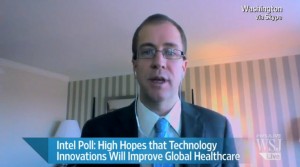You’ve heard of wearables in healthcare technology, but have you considered swallowables? Swallowing a piece of electronics is something that people are actually willing to try.
Just this morning, Intel released results from a very compelling study on a range of consumer interest in electronic “wearables” and monitors. They asked people how willing they are to try:
- Wrist monitors that can monitor things like respiration, blood pressure, heart rate and more, without a cuff – you’ve seen these in Nike Fuel Band and the FitBit Flex, among others.
- Toilet sensors – you read that correctly.
- Prescription bottle sensors
- Blood pressure cuffs
- The swallowable sensor
- and more
This particular study reminded us of another study by Forrester that asked people which types of wearables they are most likely to try. In Forrester Research‘s version of of the famous Vitruvian Man, a male dressed in a business suit shows how a variety of wearable devices might became part of the modern man.
We recently addressed the topic with our own perspectives on the “quantified self” and how healthcare providers can address this changing consumer mindset.
“The self-quantifying patient will be the solution to population health management as smart phones become ubiquitous and allow evidence-based healthcare professionals to guide medical decision making.”
In our white paper, Beyond Gamification: Revolutionizing Healthcare with the Quantified Self“, we address the challenge of keeping individuals engaged in their health through gamified healthcare applications, active/passive health data collection and action-oriented analytics.
Here is the video interview with Dishman:
Intel Poll: Technology Will Improve Healthcare



